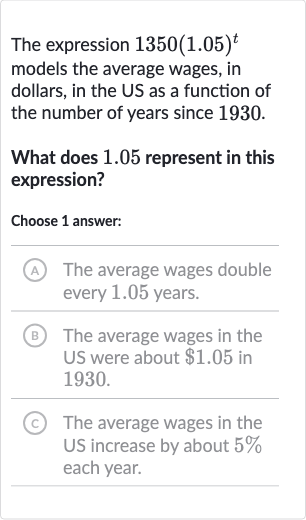AI tutor
Welcome to Bytelearn!
Let’s check out your problem:

The expression models the average wages, in dollars, in the US as a function of the number of years since .What does . represent in this expression?Choose answer:(A) The average wages double every . years.(B) The average wages in the US were about in .(C) The average wages in the US increase by about each year.
Full solution
Q. The expression models the average wages, in dollars, in the US as a function of the number of years since .What does . represent in this expression?Choose answer:(A) The average wages double every . years.(B) The average wages in the US were about in .(C) The average wages in the US increase by about each year.
- Expression Structure: The expression given is , where represents the number of years since . To understand what represents, we need to look at the structure of the expression. It is an exponential function, where the base of the exponent indicates the rate of change per year.
- Rate of Change: In the context of the problem, since the base of the exponent is greater than , it suggests that the quantity is increasing over time. Specifically, a base of indicates a increase each year because can be thought of as (the original amount) plus (the increase).
- Evaluation of Options: Now, let's evaluate the options given:(A) The average wages double every years. - This is incorrect because the expression does not imply doubling; it implies a steady growth rate.(B) The average wages in the US were about in . - This is incorrect because the is not a dollar amount; it's a multiplier for the growth rate.(C) The average wages in the US increase by about each year. - This is correct because the base of the exponent represents a increase.
More problems from Write exponential functions: word problems
QuestionGet tutor help
QuestionGet tutor help
QuestionGet tutor help
QuestionGet tutor help
QuestionGet tutor help
QuestionGet tutor help
QuestionGet tutor help
QuestionGet tutor help
QuestionGet tutor help
